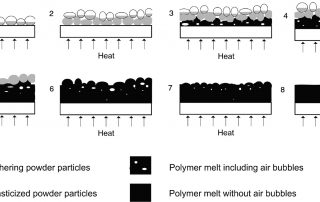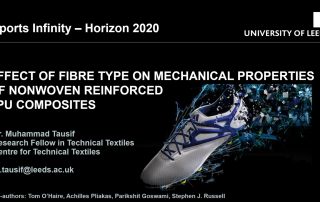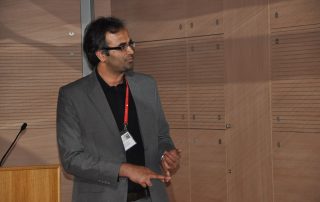Experimental Studies on the Bonding Strength and Fracture Behavior of Incompatible Materials Bonded by Mechanical Adhesion in Multi-layer Rotational Molding
LKT Paper – Löhner, M.; Drummer, D., Journal of Polymers (Hindawi)
Accepted on November 1st 2016
Abstract: Rotational molding is a plastic processing method that allows for the production of seamless, hollow parts. A defined shaping of the polymeric material only takes place on the outer surface where contact to the tooling is given. The inner surface forms by surface tension effects. By sequential adding of materials, complex multi-layer built-ups are possible. Besides pure, single materials, filled or multiphase systems can be processed as well. In this work, possibilities to generate bonding between supposedly incompatible materials by adding a mix-material interlayer are investigated. Interlock mechanisms on a micro-scale dimension occur and result in mechanical bonding between the used materials, Polyethylene (PE) and Thermoplastic Polyurethane (TPE-U). The bonding strength between the materials was investigated to reveal the correlations between processing parameters, resulting layer built-up, and bonding strength. The failure behavior was analyzed and inferences to the influence of the varied parameters were drawn.
Optimierung der Verbundhaftung von mehrlagigen, rotationsgeformten Bauteilen durch Einbringen einer mehrphasigen Zwischenschicht
LKT Paper Löhner, M.; Drummer, D., Zeitschrift Kunststofftechnik.
Accepted on October 4th 2016
Abstract: Rotational molding is a plastic processing method to produce hollow, seamless polymer parts with potentially complex geometries and large volumes such as tanks in various applications. Multi-layer parts can be generated mold independently by sequentially adding different materials into the mold. In this work, the bonding strength of multi-layer parts with a blended interlayer was investigated. The material combination used was Polyamide 12 – Polyethylene.
Characterization of layer built-up and inter-layer boundaries in rotational molding of multi-material parts in dependency of the filling strategy
LKT Paper – Journal of Polymer Engineering – De Gruyter
Martin Löhner / Dietmar Drummer
Journal of Polymer Engineering. ISSN (Online) 2191-0340, ISSN (Print) 0334-6447, DOI: 10.1515/polyeng-2016-0175, August 2016
Abstract: In rotational molding, shaping is achieved by elevating the temperature of polymer powder particles above their melting temperature, causing them to adhere to the mold wall. Multi-layer parts can be processed by sequential adding of different polymeric materials to the mold, while the thickness of each layer is defined by the amount of each material. In this work, the influence of adding time of a second component on the shape and development of the interface region between different materials for multi-layer rotational molding is investigated. Therefore, rotational molding experiments were conducted using an uniaxial rotating molding machine and a cylindrical mold. Varying the time of second material addition yielded different specific interface regions. The cross sections of the resulting multi-layer parts were analyzed using transmitted light microscopy and characteristic values were derived to describe the interfaces. Single-layer parts were produced to verify the built-up of the polymer layer and the development of the inner melt surface in rotational molding.
Leeds University presentation at 16th World Textile Conference AUTEX 2016
Tausif, M, O’Haire, T, Pliakas, A et al. (2 more authors) (2016) Effect of Fibre Type on Mechanical Properties of Nonwoven Reinforced TPU Composites. In: 16th World Textile Conference AUTEX 2016, 08-10 Jun 2016, Ljubljana, Slovenia. . (In Press)
Abstract: Nonwoven-reinforced composites were produced using both low modulus fibres (lyocell, polyethylene terephthalate, and polyamide) and high modulus aramid fibres (polyphenylene terephthalamide) in thermoplastic polyurethane (TPU) matrix. Preferentially oriented web preforms were prepared by carding and pre-needling before impregnating the nonwovens in a thermoplastic polyurethane resin matrix. Composites were prepared by compression moulding and mechanical properties were evaluated. Scanning Electron Microscopy was employed to study the fibre-to-matrix interface in the nonwoven-reinforced composites. It was found that nonwoven reinforcement provided a range of mechanical properties, mainly linked to fibre properties and orientation of fibres in the web, apparently unaffected by the mechanical properties of the web. Furthermore, all studies fibres were thoroughly embedded in the matrix.



